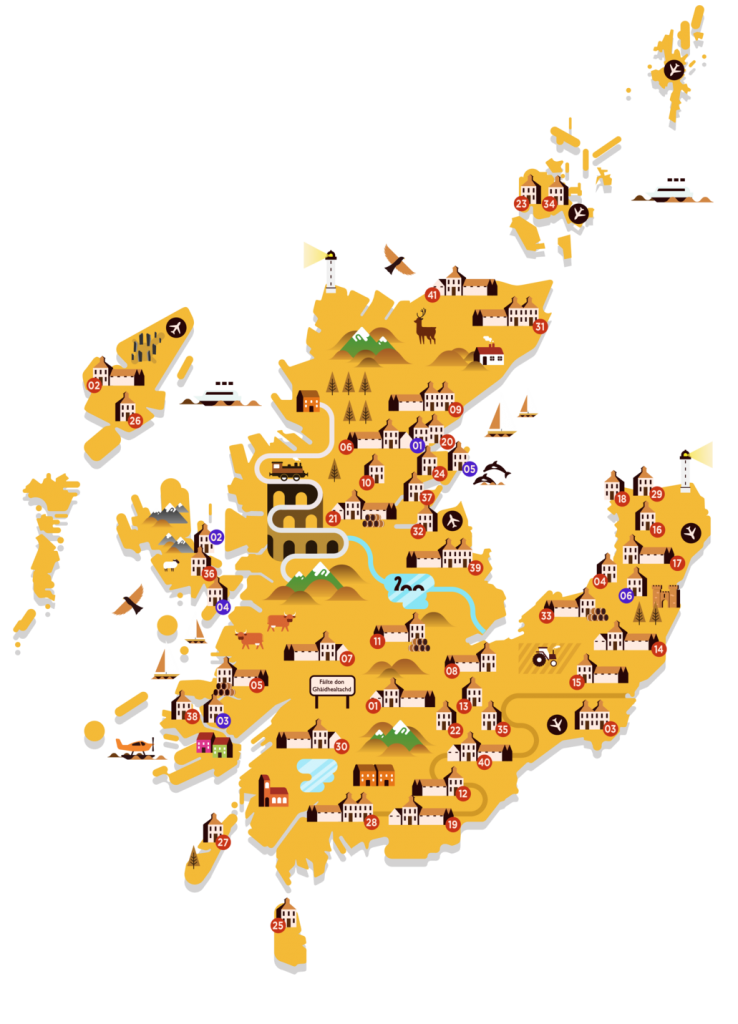Stretching from Orkney in the north to the Isle of Arran in the south and Aberdeenshire to the Outer Hebrides east to west, the Highland region is the biggest geographical whisky area in Scotland.
The Highland takes up most of the country, which means there is a great variation present in the region — malts range from dry to sweet.
As a result, its whiskies are not easy to categorize. Broadly speaking, they are robust, full-bodied single malts that also embrace individual characteristics depending on the distillery and location. Some are peaty or smoky, and some are powerful, but others, such as those produced at Dalwhinnie, are surprisingly delicate.
Fruitcake and oak flirt with heather and smoke in Highland Whiskies. Wild seas and impenetrable moorland dominate the landscape, creating a breeding ground for powerful peaty drams, whilst still leaving room for floral, silky elegance
Running through the volcanic mountain rock of the Highlands, the water here is some of the purest in Scotland.
If we contrast the compass points, distilleries in the northern Highlands generally produce whisky with full-bodied, sweet malts with cereal notes; in the south, whiskies tend to be lighter, fruity and dry. Single malts from Aberdeenshire in the east are full-bodied, dry and fruity compared with the western Highlands, which are peated with strong maritime influences.
The distilleries on the islands, although officially not recognized as a sub-region, differ again. Highland Park on Orkney, for instance, is different to most mainland Highland malts because the 4,000-year-old heathery peat used to dry its malted barley gives it a sweet smokiness.
In general, Highland malts tend to be more robust, with more pronounced flavors and aroma, and significantly more weight and texture on the palate. In addition, there are regional characteristics that reflect the impact of climate and terrain as well as the source of fuel used to dry the malted barley.
Northern Highland
Northern Highland’s whiskies are full bodied, sweet, and rich. These malts show distinctive cereal aromas, along with fruit and nutty notes. There is lots of variety among Northern Highlanders:
Southern/Central Highlands/Midlands
Southern Highland whiskies are slightly lighter, drier, and distinctly fruity. The style has more in common with Lowland malts than its more robust northern cousins. Here too, the choice of cask finishing will introduce a broader range of aromas and flavors than is typical for the region.
Western Highlands
Eastern Highlands
Distilleries
Mill Location Mill Location
| 1 | Aberfeldy | Aberfeldy |
| 2 | Arbikie | Inverkeilor |
| 3 | Ardmore | Kennethmont |
| 4 | Ardnamurchan | Ardnamurchan |
| 5 | Balblair | Edderton |
| 6 | Ben Nevis | Fort William |
| 7 | Blair Athol | Pitlochry |
| 8 | Clynelish | Brora |
| 9 | Dalmore | Alness |
| 10 | Deanston | Doune |
| 11 | Edradour | Pitlochry |
| 12 | Fettercairn | Laurencekirk |
| 13 | Glen Garioch | Oldmeldrum |
| 14 | Glen Ord | Muir of Ord |
| 15 | Glencadam | Angus |
| 16 | Glendronach | Aberdeenshire |
| 17 | Glenglassaugh | Portsoy |
| 18 | Glengoyne | Dumgoyne |
| 19 | Glenmorangie | Tain |
| 20 | Glenturret | Crieff |
| 21 | Knockdhu | Knock |
| 22 | Loch Lomond | Alexandria |
1
| 23 | Lochnagar | Ballater |
| 24 | LoneWolf | Ellon |
| 25 | Macduff | Banff |
| 26 | nvergordon | Easter Ross |
| 27 | Oban | Oban |
| 28 | Pulteney | Wick |
| 29 | Royal Brackla | Nairn |
| 30 | Royal Brackla | Nairn |
| 31 | Scapa | Kirkwall |
| 32 | Strathearn | Methven |
| 33 | Teaninich | Alness |
| 34 | Tomatin | Tomatin |
| 35 | Tullibardine | Blackford |
| 36 | Wolfburn | Thurso |
| 37 | Abhainn Dearg | Isle of Lewis |
| 38 | Arran | Lochranza |
| 39 | Highland Park | Kirkwall |
| 40 | Isle of Jura | Jura |
| 41 | Scapa | Kirkwall |
| 42 | Talisker | Carbost, Isle of Skye |
| 43 | Tobermory | Isle of Mull |
| 44 | Torabhaig | Teangue, Isle of Skye |

